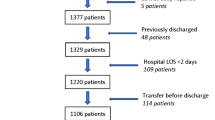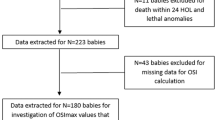Abstract
OBJECTIVE:
Outcomes analysis in congenital diaphragmatic hernia (CDH) requires a validated risk-adjustment tool. The purpose of this study was to use the Canadian Neonatal Network (CNN) database to validate the Score for Neonatal Acute Physiology, Version II (SNAP-II) for prediction of mortality among CDH infants admitted to a neonatal intensive care unit (NICU), and to compare this to the predictive equation recently developed by the Congenital Diaphragmatic Hernia Study Group (CDHSG).
STUDY DESIGN:
Infants with CDH in the CNN database were identified. Bivariate and multivariable logistic regression models were used to identify risk factors predictive of mortality. Model predictive performance and calibration were assessed using the area under the receiver operator characteristic curve and the technique of Hosmer-Lemeshow, respectively, and compared with the CDHSG predictive equation.
RESULTS:
There were 88 patients with CDH among 19,507 admissions to CNN hospitals. The mortality rate among CDH patients surviving to NICU admission was 17%, and 12.5% received extracorporeal membrane oxygenation therapy. Gestational age and admission SNAP-II score predicted mortality. Model predictive performance and calibration were optimized with these variables combined. The CDHSG equation was equally predictive of mortality, but was only marginally calibrated.
CONCLUSIONS:
SNAP-II is highly predictive of mortality among patients with CDH, and can be used to risk-adjust these patients.
This is a preview of subscription content, access via your institution
Access options
Subscribe to this journal
Receive 12 print issues and online access
$259.00 per year
only $21.58 per issue
Buy this article
- Purchase on Springer Link
- Instant access to full article PDF
Prices may be subject to local taxes which are calculated during checkout

Similar content being viewed by others
References
The Congenital Diaphragmatic Hernia Study Group. Estimating disease severity of congenital diaphragmatic hernia in the first 5 minutes of life. J Pediatr Surg 2001;36:141–145.
Richardson DK, Corcoran JD, Escobar GJ, et al. SNAP-II and SNAPPE-II: simplified newborn illness severity and mortality risk scores. J Pediatr 138;2001:92–100.
Lee SK, MacMillan DD, Ohlsson A, et al. Variations in practice and outcomes in the Canadian NICU network: 1996–1997. Pediatrics 2000;106:1070–1079.
World Health Organization. International Classification of Diseases. 10th rev. Geneva: The Organization; 2001.
Hanley JA, McNeil BJ . The meaning and use of the area under a receiver operating characteristic (ROC) curve. Radiology 1982;143:29–36.
Lemeshow S, Hosmer Jr DW . A review of goodness of fit statistics for use in the development of logistic regression models. Am J Epidemiol 1982;115:92–106.
Cacciari A, Ruggeri G, Mordenti M, et al. High-frequency oscillatory ventilation versus conventional mechanical ventilation in congenital diaphragmatic hernia. Eur J Pediatr Surg 2001;11:3–7.
Miguet D, Claris O, Lapillonne A, et al. Preoperative stabilization using high-frequency oscillatory ventilation in the management of congenital diaphragmatic hernia. Crit Care Med 1994;22 (9 Suppl):S77–82.
Arnold JH . High-frequency ventilation in the pediatric intensive care unit. Pediatr Crit Care Med 2000;1:93–99.
Okuyama H, Kubota A, Oue T, et al. Inhaled nitric oxide with early surgery improves the outcome of antenatally diagnosed congenital diaphragmatic hernia. J Pediatr Surg 2002;37:1188–1190.
Somaschini M, Locatelli G, Salvoni L, et al. Impact of new treatments for respiratory failure on outcome of infants with congenital diaphragmatic hernia. Eur J Pediatr 1999;158:780–784.
Kinsella JP, Parker TA, Ivy DD, et al. Noninvasive delivery of inhaled nitric oxide therapy for late pulmonary hypertension in newborn infants with congenital diaphragmatic hernia. J Pediatr 2003;142:397–401.
Clark RH, Hardin Jr WD, Hirschl RB, et al. Current surgical management of congenital diaphragmatic hernia: a report from the Congenital Diaphragmatic Hernia Study Group. J Pediatr Surg 1998;33:1004–1009.
Desfrere L, Jarreau PH, Dommergues M, et al. Impact of delayed repair and elective high-frequency oscillatory ventilation on survival of antenatally diagnosed congenital diaphragmatic hernia: first application of these strategies in the more "severe" subgroup of antenatally diagnosed newborns. Intensive Care Med 2000;26:934–941.
Reyes C, Chang LK, Waffarn F, et al. Delayed repair of congenital diaphragmatic hernia with early high-frequency oscillatory ventilation during preoperative stabilization. J Pediatr Surg 1998;33:1010–1016.
Frenckner B, Ehren H, Granholm T, et al. Improved results in patients who have congenital diaphragmatic hernia using preoperative stabilization, extracorporeal membrane oxygenation, and delayed surgery. J Pediatr Surg 1997;32:1185–1189.
Kamata S, Usui N, Ishikawa S, et al. Prolonged preoperative stabilization using high-frequency oscillatory ventilation does not improve the outcome in neonates with congenital diaphragmatic hernia. Pediatr Surg Int 1998;13:542–546.
Moyer V, Moya F, Tibboel R, et al. Late versus early surgical correction for congenital diaphragmatic hernia in newborn infants. Cochrane Database Syst Rev 2002;(3):CD001695.
Walsh DS, Adzick NS . Fetal surgical intervention. Am J Perinatol 2000;17:277–283.
Flake AW . Fetal surgery for congenital diaphragmatic hernia. Semin Pediatr Surg 1996;5:266–274.
Flake AW, Crombleholme TM, Johnson MP, et al. Treatment of severe congenital diaphragmatic hernia by fetal tracheal occlusion: clinical experience with fifteen cases. Am J Obstet Gynecol 2000;183:1059–1066.
Harrison MR, Sydorak RM, Farrell JA, et al. Fetoscopic temporary tracheal occlusion for congenital diaphragmatic hernia: prelude to a randomized, controlled trial. J Pediatr Surg 2003;38:1012–1020.
Stege G, Fenton A, Jaffray B . Nihilism in the 1990s: the true mortality of congenital diaphragmatic hernia. Pediatrics 2003;112:532–535.
Javid PJ, Jaksic T, Skarsgard ED, et al. Survival in congenital diaphragmatic hernia: the experience of the Canadian Neonatal Network. J Pediatr Surg 2004;39:657–660.
Downard CD, Jaksic T, Garza JJ, et al. Analysis of improved survival rate for congenital diaphragmatic hernia. J Pediatr Surg 2003;38:729–732.
Langer JC, Filler RM, Bohn DJ, et al. Timing of surgery for congenital diaphragmatic hernia: is emergency operation necessary? J Pediatr Surg 1988;23:731–734.
Acknowledgements
This study was supported by Grant 40503 and Grant 00152 from the Medical Research Council of Canada. Additional funding was provided by the B.C.'s Children's Hospital Foundation; Calgary Regional Health Authority; Division of Neonatology, Children's Hospital of Eastern Ontario; Child Health Program, Dalhousie University Neonatal Perinatal Research Fund; Health Care Corporation of St. John's; The Neonatology Program, Hospital for Sick Children; Lawson Research Institute; Midland Walwyn Capital Inc; Division of Neonatology, Hamilton Health Sciences Corporation; Mount Sinai Hospital; North York General Hospital Foundation; Saint Joseph's Health Centre; University of Saskatchewan Neonatal Research Fund; University of Western Ontario; Women's College Hospital. We thank Jennifer Claydon for her assistance in data collection and manuscript preparation.
Author information
Authors and Affiliations
Consortia
Rights and permissions
About this article
Cite this article
Skarsgard, E., MacNab, Y., Qiu, Z. et al. SNAP-II Predicts Mortality among Infants with Congenital Diaphragmatic Hernia. J Perinatol 25, 315–319 (2005). https://doi.org/10.1038/sj.jp.7211257
Published:
Issue Date:
DOI: https://doi.org/10.1038/sj.jp.7211257
This article is cited by
-
Ventilation-to-perfusion relationships and right-to-left shunt during neonatal intensive care in infants with congenital diaphragmatic hernia
Pediatric Research (2022)
-
Predicting clinical outcomes using artificial intelligence and machine learning in neonatal intensive care units: a systematic review
Journal of Perinatology (2022)
-
Prediction of survival in infants with congenital diaphragmatic hernia and the response to inhaled nitric oxide
European Journal of Pediatrics (2022)
-
Comparison of early postnatal prediction models for survival in congenital diaphragmatic hernia
Journal of Perinatology (2019)
-
Survival prediction of high-risk outborn neonates with congenital diaphragmatic hernia from capillary blood gases
BMC Pediatrics (2016)



